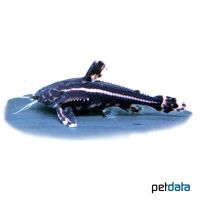Chocolate Talking Catfish (Acanthodoras cataphractus)
| Chocolate Talking Catfish Acanthodoras cataphractus | |
|---|---|
| Name | Chocolate Talking Catfish |
| Name Lat. | Acanthodoras cataphractus |
| Family | Thorny Catfishes |
| Family lat. | Doradidae |
| Order | Catfishes |
| Order lat. | Siluriformes |
| Origin | South America |
| Habitat | Rivers, lakes |
| Diet | Omnivore |
| pH | 6.0-7.5 |
| Behavior | Nocturnal, peaceful |
| Keeping | Group |
| Care Level | Moderate |
| Reproduction | Substrate spawner |
| Breeding | Difficult |
| Life Span | 10-15 years |
| Protection | No |
| Metric Units | |
| Size | 10 cm |
| Temperature | 22-26 °C |
| Hardness | 5-20 °dH |
| Aquarium | ~ 240 l |
| US Units | |
| Size | 4" |
| Temperature | 72-79 °F |
| Hardness | 89-356 ppm |
| Aquarium | ~ 65 gal |
Distribution and habitat
The crepuscular to nocturnal common spiny catfish are widespread in the northern reaches of the Amazon (Bolivia, Peru, Colombia, Brazil) and in estuaries in Guyana, Suriname and French Guiana. They live in the slow-flowing and stagnant waters, where they spend the day hidden among roots, plants and stones or burrowed in the bottom.
Maintenance
The aquarium should have dense planting, many shady hiding places (roots, stones, caves), subdued light (floating plants) and a weak current. To be able to burrow, they need a soft, fine-grained substrate (sand, round gravel).
No ammonia, ammonium and nitrite should be detectable, the nitrate value should not exceed 100 mg/l. To ensure the water quality and oxygen content, a filter and heater adapted to the aquarium size is required, as well as lighting for the species-appropriate day-night rhythm of the animals.
Diet
They are omnivores and unproblematic in feeding. The food supply consists of live, frozen and dry food. For a balanced diet, feed at least once a day with a high-quality sinking dry food for catfish (food tablets, granules, pellets) as well as cyclops, daphnia, artemia and mosquito larvae (live or frozen)
Only feed as much as will be eaten overnight. Regular and varied feeding promotes health and prevents deficiency symptoms
Behaviour and compatibility
They are peaceful fish that are compatible with each other and are well suited for a community tank, although fish that are too small are considered food. A group of at least 4 animals should always be kept together
Basically, only compatible fish species with similar demands on water condition and water temperature should be socialized.
Sex dimorphism
There are no known external distinguishing characteristics.
Reproduction and breeding
Breeding in the aquarium is said to have succeeded occasionally. Thus, the parents are said to dig a shallow trough for egg laying. The larvae hatch after 4-5 days. It is not known if the parents are brooders.
Important
They can make creaking sounds with their shoulder girdle and are therefore sometimes called "talking catfishes".
When fishing, use the finest mesh nets possible to avoid snagging the hard rays of the pectoral and dorsal fins, which can cause painful puncture wounds when touched.
The well-being of the fish should be checked regularly. Temperature should be checked daily, pH, hardness and nitrate levels at least every 14 days. Regular partial water changes are recommended, even when contaminant levels have not yet reached the upper limit. Sudden changes in water quality should be avoided. Newly introduced fish must be accustomed slowly to the water in the aquarium.
Further literature can be found in your pet store.
References
Text: Werner Winter; Image: petdata
Source: BMELV (1998): Tierschutzgutachten - Haltung von Zierfischen (Süßwasser); RIEHL & BAENSCH (2006): Aquarien Atlas Bd. 1, Mergus Verlag; ENGELMANN (2005): Zootierhaltung - Tiere in menschlicher Obhut: Fische, Verlag Harri Deutsch
- Gemäß § 21 Abs. 5 Tierschutzgesetz idgF
